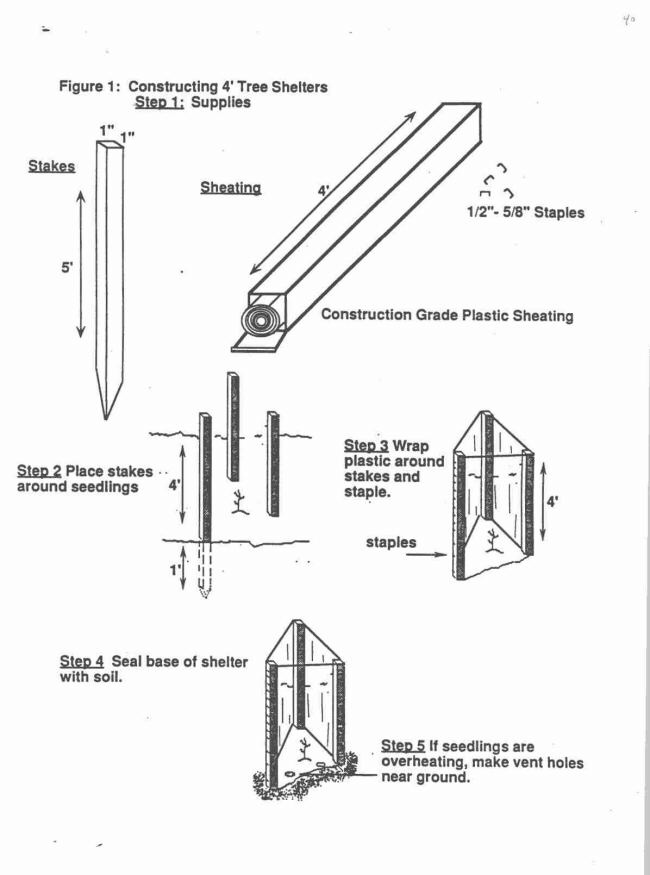Cooperative Extension Service
Increasing Hardwood Planting Success Using Tree Shelters
Tree Shelters
Several thousand hardwood seedlings are planted each year in Michigan. While some survive and grow, many grow poorly and eventually die. Death is the result of many factors including incorrect species-site selection, low quality planting stock, and poor planting technique. Additionally, lack of weed control, and/or protection from animal browse contribute to plantation failures. Northern red oak and black walnut are two of the most common hardwood tree species planted in Michigan. High market values for products derived from these species and decreasing numbers of quality trees in natural stands has encouraged increased planting. However, planting success is often poor due to problems with deer browse, slow growth and poor form. Tree shelters, a newly developed concept and product, can contribute to eliminating or reducing some of these establishment problems. Tree shelters act as small greenhouses, enhancing the environment for growth for some tree species, and providing protection from deer browse. Tree shelters were developed in Great Britain. Since 1979, different combinations of height, diameter, color and design have been tested. Growth responses have consistently been positive for most tested designs. Improvements in height growth, varying from 200 to 500 percent, were recorded for sheltered seedlings of some tree species. Over the past 10 years, British plastic manufacturers have produced in excess of 6 million tree shelters for use in establishing hardwood plantations.
How Tree Shelters Work
Relative humidity and air temperatures in the shelter are higher throughout the growing season. This has encouraged oak seedlings to exhibit multiple flushes of growth by the terminal leader. Studies have also indicated an increase in the level of carbon dioxide present within the shelters. Higher levels of carbon dioxide improve plant growth. Sheltered trees also reallocate growth away from branches and increases in stem diameter, thereby providing the terminal leader with additional resources for growth. This may result in improved tree form and stem quality. As a result of reduced stem diameter growth, however, diameters are insufficient to support seedlings in an upright position for the first I to 2 years after exiting the shelter. Shelters must remain in place to provide' support or the seedling has to be supported by a stake at the time of shelter removal.
Research in Michigan has shown the average height of sheltered northern red oak seedlings to be almost twice that of unsheltered seedlings after two growing seasons. Over 64 percent of sheltered seedlings were 3 ft or taller in two years from planting. Only 22 percent of unsheltered seedlings were 3 ft or taller.
How to Construct and Install Tree Shelters
Shelters can be constructed with stakes, staples, and construction grade plastic sheeting (Fig. 1). The height and diameter of tree shelters can be made to accommodate the objective of the landowner. Two foot high shelters may be sufficient to reduce rodent and rabbit damage but will result in little growth improvement and no protection from deer browse. Growth benefits and protection from deer browsing would require shelters +to 6 feet tall. Diameter of tree shelters can range from 3 to 8 inches. Larger diameters are more expensive to construct and provide no apparent additional benefit to tree seedlings. Figure 2 illustrates the steps required to construct a tree shelter. One inch square stakes of white oak, black locust, cedar or treated pine are recommended. Three stakes are driven in the ground around each seedling to form a triangle. Construction grade plastic sheeting, available at most lumber supply stores, is wrapped around the triangle of stakes. The plastic is then stapled to the stakes. The plastic sheeting should come in contact with the ground to minimize,, the flow of air through the shelter. However, a word of caution is in order. Overheating has been experienced with northern red oak in shelters that were sealed where they contacted the ground. Monitor all seedlings for dieback due to overheating and ventilate the shelter with a small opening if required. In addition, only northern red oak and black walnut have been tested in shelters in Michigan.
Concerns In The Use Of Tree Shelters
Manufactured tree shelters are expensive. They cost between $2.50 and $4.00 apiece. Adding this cost to that of stakes and installation labor may prohibit large scale use.
Installed shelters also require frequent checking to insure proper performance. Broken stakes cause shelters to fall and damage enclosed seedlings, and stem abrasion and breakage occur at the top edge of poorly maintained shelters. Homemade shelters require higher levels of maintenance compared to pre-constructed. All shelters must be inspected frequently to insure proper plantation establishment.
Environmental concerns need to be considered. Shelters are constructed of plastic; if they are allowed to degrade in the field as designed plastic litter is the by-product. Cleanup or removal costs should also be considered when using tree shelters Tree shelters appear to work on red oak and walnut, but the technology is new and requires further refinement and testing on other tree species. Tree shelters do not solve the problems of poor seedling handling, planting technique, species-site selection or weed control. Tree planting still requires forethought and knowledge before tree shelters are helpful
Now there are a number of commercial tree shelters on the market that are widely used to protect seedlings from deer browsing damage. Some manufacturers include:
| Manufacturer | Manufacturer |
|---|---|
|
Treeessential Company
2731 Waters Drive Mendota Heights, MN 800-248-8239 www.treessentials.com |
Tree Sentry, Inc. P.O. Box 607 55120Perrysburg, OH 43552 419-872-6950 |
| Tree Pro 3180 W. 250 N. West Lafayette, IN 47906 800-875-807 www.treepro.com |
McKnew Enterprises
P.O. Box 2128 Elk Grove, CA 97758 (888) 47-BLUEX www.growtube.com/shelters.html |
